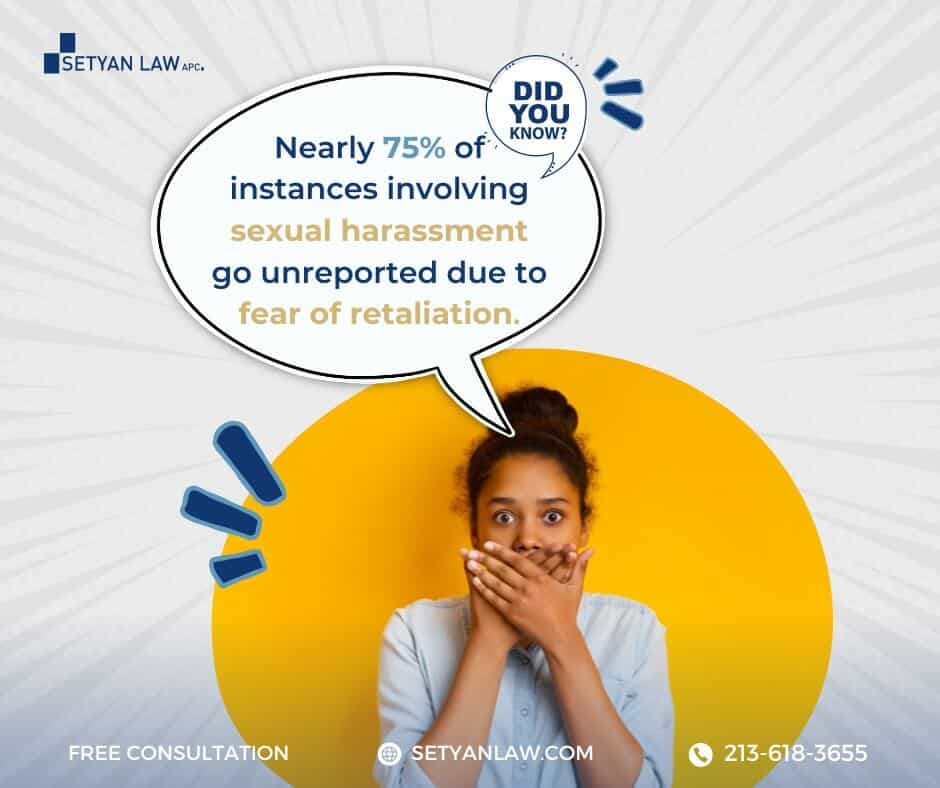Updated August 23, 2025
How to Mitigate Sexual Harassment in the Workplace: A Survivor’s Guide
Sexual harassment in the workplace affects nearly 1 in 4 women and 1 in 10 men, yet only a fraction of incidents are ever reported.
Unfortunately, many survivors stay silent due to fear of retaliation, damage to their career, or simply not knowing what steps to take. Despite workplace policies and legal protections, navigating this difficult situation can feel overwhelming and isolating when you’re the one experiencing it.
You have the right to work in an environment free from harassment and intimidation. When that right is violated, you deserve to know exactly how to protect yourself, assert your legal rights, and hold harassers accountable.
This survivor’s guide provides practical, step-by-step advice for documenting incidents, reporting harassment, understanding your legal options, and protecting your wellbeing throughout the process. Whether you’re currently experiencing harassment or supporting someone who is, this resource will help you take back control of your workplace experience.
Above all, remember that you are not alone, and you do have options—no matter how powerless you might feel right now.
Understanding Workplace Sexual Harassment
Recognizing workplace sexual harassment begins with understanding what it actually looks like. According to the Equal Employment Opportunity Commission (EEOC), sexual harassment includes unwelcome sexual advances, requests for sexual favors, and verbal or physical conduct of a sexual nature that affects employment conditions or creates a hostile work environment.
Types of harassment: Quid pro quo and hostile environment
Workplace sexual harassment falls into two distinct categories, each with different characteristics but equally damaging effects.
Quid pro quo harassment (Latin for “this for that”) occurs when job benefits are tied to sexual favors. This type specifically involves someone in a position of power making employment decisions based on submission to or rejection of unwelcome sexual conduct. Essentially, it creates a situation where sexual compliance becomes a condition of employment or advancement.
A supervisor threatening termination unless an employee agrees to a date or promising a promotion in exchange for sexual favors represents classic examples of quid pro quo harassment. Notably, even a single incident can constitute quid pro quo harassment, making it immediately actionable.
Hostile work environment harassment occurs when unwelcome sexual conduct is so severe or pervasive that it creates an intimidating, offensive, or abusive workplace. Unlike quid pro quo, this form doesn’t necessarily involve direct threats to job status. Furthermore, it can be perpetrated by anyone in the workplace—supervisors, coworkers, or even non-employees like vendors or customers.
Examples of inappropriate behavior
Inappropriate workplace behaviors that constitute sexual harassment include:
- Unwanted touching, hugging, kissing, or other physical contact
- Sexual jokes, comments, or innuendos
- Displaying sexually explicit images or objects
- Unwelcome comments about someone’s body or appearance
- Repeatedly asking for dates after being refused
- Blocking someone’s path in a sexual manner
- Sexually suggestive gestures
- Sending inappropriate emails, texts, or messages
- Spreading rumors about someone’s sex life
- Stalking or unwanted attention
Certain behaviors might seem harmless to some but can create a hostile environment if they make others uncomfortable or interfere with their ability to work effectively.
Why intent doesn’t matter—impact does
A crucial aspect of workplace sexual harassment is understanding that the harasser’s intent is not the determining factor—the impact on the recipient is what matters. As one military resource states, “It is not the intent, but is the perception and impact which determines whether or not an act is sexual harassment”.
The focus on impact rather than intent is intentional in harassment laws. Sexual harassment is inherently subjective; what one person considers acceptable might be deeply offensive to another. Consequently, the evaluation of harassment is based primarily on how the recipient perceives the behavior.
This principle is reinforced in harassment policies worldwide. Under various frameworks, including the POSH Act in India, “unwelcome behavior” is the key criterion. The behavior must be unwelcome from the recipient’s perspective, regardless of whether the perpetrator meant no harm or considered their actions complimentary or harmless.
Organizations must recognize that good intentions don’t excuse actions perceived as unwelcome or offensive. Creating a safe workplace environment requires valuing impact over intent when addressing potential harassment situations.
Know Your Legal Rights
Understanding your legal rights can empower you to take appropriate action when facing sexual harassment in the workplace. Federal and state laws provide crucial protections that every employee should know about.
Federal protections under Title VII
Title VII of the Civil Rights Act of 1964 serves as the primary federal shield against workplace sexual harassment. This landmark legislation prohibits employment discrimination based on sex, which courts have interpreted to include sexual harassment. Importantly, Title VII applies to employers with 15 or more employees, including state and local governments, employment agencies, labor organizations, and federal government agencies.
Under Title VII, your employer cannot legally:
- Discriminate regarding hiring, firing, or other employment terms based on sex
- Allow sexual harassment to create a hostile work environment
- Fail to take prompt action when harassment is reported
- Retaliate against you for reporting harassment
The Equal Employment Opportunity Commission (EEOC) enforces Title VII and investigates harassment complaints. Should you decide to file with the EEOC, you must do so within 300 days of the harassment incident. After investigation, if the EEOC finds reasonable cause to believe discrimination occurred, they will issue a Right to Sue letter allowing you to pursue a federal lawsuit.
State-specific laws and additional protections
While federal law provides baseline protections, many states offer stronger safeguards against sexual harassment. These state-level protections often:
- Apply to smaller employers (sometimes covering workplaces with just one employee)
- Provide longer filing deadlines than federal law
- Allow higher damage awards in lawsuits
- Include additional protected categories
For instance, California’s Fair Employment and Housing Act (FEHA) applies to all California employers, provides broader protections than Title VII, and covers independent contractors, interns, and volunteers. Meanwhile, New York requires all employers to develop sexual harassment policies.
Currently, all 50 states plus the District of Columbia and Puerto Rico prohibit sex discrimination, with 39 states explicitly stating that sexual harassment is not permitted in workplaces. Furthermore, eight states require employers to provide sexual harassment training.
To understand your specific state’s protections, consult your state’s civil rights or labor department website, or speak with an employment attorney familiar with local laws.
What retaliation looks like and why it’s illegal
Retaliation occurs when an employer punishes an employee for engaging in legally protected activity, such as reporting sexual harassment. Both federal and state laws strictly prohibit this practice.
The EEOC defines retaliation as: (1) participating in a protected activity; (2) experiencing a materially adverse action by the employer; and (3) establishing a causal connection between the protected activity and the adverse action.
Retaliation can manifest in numerous ways, including:
- Termination or demotion
- Undeserved negative performance reviews
- Reduction in hours or responsibilities
- Reassignment to less desirable positions
- Social or professional isolation
- Denial of promotion or training opportunities
- Increased scrutiny or micromanagement
Moreover, retaliation protections extend beyond just the person who filed the complaint. The law also shields employees who testify in investigations, oppose discriminatory practices, or assist others in exercising their rights.
Significantly, you can win a retaliation case even if your harassment claim is ultimately unsuccessful. As long as you reported the harassment in good faith, the law protects you from punishment for speaking up.
Remember: An employer is always legally responsible for harassment by a supervisor that results in tangible employment action, regardless of whether you complained about the harassment. Understanding these protections gives you the foundation to assert your rights effectively when facing sexual harassment in the workplace.
Steps to Take if You’re Being Harassed
Taking appropriate action against sexual harassment requires both courage and strategy. When facing inappropriate workplace behavior, these concrete steps will help you protect yourself and build a strong case.
Document every incident in detail
Thorough documentation creates a paper trail that substantiates your experience. After each incident:
- Record the date, time, location, and specific details of what happened
- Note exactly what was said or done, using direct quotes when possible
- Identify any witnesses present
- Document how the incident made you feel and how it affected your work
- Save any physical evidence, including emails, texts, notes, or pictures
- Keep this information in a secure location outside your workplace, such as a personal email account or home computer
Meticulous documentation helps establish patterns of behavior, particularly important since harassment often occurs as a series of incidents rather than isolated events.
Tell the harasser to stop if you feel safe
Sometimes, directly addressing the harasser can effectively end unwanted behavior. If you feel physically and emotionally safe doing so:
- Be clear, direct, and specific about the behavior that makes you uncomfortable
- Use “I” statements such as “I feel uncomfortable when you comment on my appearance”
- Maintain a professional tone and avoid accusations
- Consider having this conversation with a witness present
- Follow up with an email summarizing the conversation for your records
However, your safety remains paramount. If direct confrontation feels unsafe or increases the harassment, proceed to other options without this step.
Review your company’s harassment policy
Before reporting, familiarize yourself with your employer’s official procedures:
- Locate the policy in your employee handbook or company intranet
- Identify the designated person or department for receiving complaints
- Note specific reporting procedures and timelines
- Understand confidentiality provisions and anti-retaliation policies
Following company protocol demonstrates your good faith effort to resolve the situation internally before pursuing external remedies.
Report to HR or a supervisor in writing
Formal reporting creates an official record that your employer cannot ignore:
- Submit your complaint in writing, keeping a copy for yourself
- Include your documented incidents with specific details
- Request a timeline for investigation and response
- Ask for written confirmation that your complaint was received
- Follow up if you don’t receive a response within the stated timeline
Remember that HR works for the company, not exclusively for employees. Therefore, maintain professional communication while being assertive about your right to a harassment-free workplace.
Consider anonymous reporting options
If you’re concerned about immediate retaliation or identification:
- Check if your company offers anonymous reporting channels
- Use an ethics hotline if available
- Consider having a trusted colleague report on your behalf
- Consult with an employment attorney before filing anonymously
Though anonymous reporting may limit the thoroughness of an investigation, it can still alert your organization to problematic behavior and potentially protect others from similar experiences.
Throughout this process, prioritize your wellbeing while methodically building your case with careful documentation and strategic reporting.
Filing a Complaint or Taking Legal Action
When internal measures fail to stop harassment, pursuing formal legal channels becomes necessary. Filing an official complaint initiates the process of holding harassers accountable through external authorities.
How to file with the EEOC or state agency
Initially, you must decide where to file your complaint. For federal protection under Title VII, file with the Equal Employment Opportunity Commission (EEOC). Alternatively, file with your state’s civil rights or fair employment agency, which typically offers additional protections.
Begin by submitting an intake questionnaire detailing your experiences. The EEOC will subsequently schedule an interview to discuss your case before formally filing your charge. Many agencies allow online submission of complaints through their official portals.
Deadlines and documentation needed
Time limits for filing are strict and non-negotiable:
- Federal (EEOC) complaints: 180 days from the harassment incident, extended to 300 days if your state has anti-discrimination laws
- State agency complaints: Varies by state (California allows three years for sexual harassment claims)
- Federal employees: Must contact an EEO counselor within 45 days
Prepare these essential documents:
- Detailed incident records with dates and descriptions
- Names of witnesses and their contact information
- Copies of any communications with the harasser
- Employment records and performance reviews
- Records of reporting to supervisors or HR
When and how to consult a lawyer
Consider hiring an attorney immediately after experiencing harassment, primarily if:
- Your employer failed to address your complaints
- You’ve experienced retaliation
- The harassment resulted in termination or demotion
- The case involves complex legal issues
Many employment attorneys offer free initial consultations and can help determine if your case has merit.
What to expect if you file a lawsuit
After filing with the EEOC or state agency, you’ll typically receive a “right-to-sue” letter allowing you to proceed with a lawsuit. You must file your lawsuit within 90 days of receiving this letter 13.
Lawsuits generally involve:
- Filing a formal complaint in the appropriate court
- Discovery phase (gathering evidence, depositions)
- Potential mediation or settlement negotiations
- Trial preparations
- Court proceedings if settlement fails
Throughout this process, remember that an attorney can guide you, negotiate maximum compensation, and protect your interests.
Protecting Your Wellbeing and Career
Navigating the aftermath of sexual harassment demands more than just legal action—it requires intentional care for your mental health and professional future. Many survivors find their wellbeing and careers at risk without proper support systems.
Seek emotional support or therapy
Professional therapy creates a structured, supportive environment where you can process trauma without judgment. Therapists specializing in workplace harassment can help you cultivate emotional freedom by reinforcing that the harassment was not your fault. They also teach valuable self-soothing techniques for managing anxiety and stress that commonly follow harassment incidents.
Consider seeking mental health practitioners experienced with post-traumatic stress disorder (PTSD), as workplace harassment often causes psychological trauma. Medical evaluations can additionally help track stress indicators and health impacts from prolonged exposure to hostile environments.
Build a support network at work and outside
Finding trustworthy confidants is crucial—yet experts suggest the best people aren’t necessarily those closest to you. Ideal supporters listen sympathetically without attempting to control your decisions or overreacting.
Initially, exercise caution about confiding in coworkers. Speaking too soon with workplace colleagues carries risks:
- They might trigger formal investigations before you’re ready
- Information could spread, leading to workplace gossip
- Some might side with the harasser, doubting your experience
Beyond personal connections, consider contacting specialized support services like domestic violence hotlines or crisis lines—even if your situation doesn’t seem severe enough. These professionals are trained specifically to provide judgment-free support and connect you with additional resources.
Know your rights if you face retaliation
After reporting harassment, your employer must protect you from both additional harassment and retaliation. Retaliation occurs when employers take adverse actions against employees for engaging in protected activities like reporting misconduct.
Recognizable forms of retaliation include:
- Reduction in hours or responsibilities
- Transfers to undesirable positions
- Termination or demotion
- Negative performance reviews
- Increased scrutiny or micromanagement
To safeguard your career while reporting, limit discussions about your complaint to necessary parties only and consider consulting with legal counsel early in the process. Remember that whistleblower protections exist specifically to shield your professional future during this challenging time.
Conclusion
Confronting sexual harassment requires courage, persistence, and knowledge of your rights. Throughout this guide, we’ve outlined concrete steps to document incidents, report inappropriate behavior, and navigate both internal and legal processes. Sexual harassment survivors often feel isolated, yet statistics clearly show this problem affects millions of workers across industries.
Importantly, your mental health deserves protection throughout this challenging journey. Therapy, trusted confidants, and specialized support services provide essential emotional scaffolding while you address the harassment. Documentation remains your strongest ally—detailed records of each incident create an undeniable timeline that strengthens your case regardless of which reporting path you choose.
Remember that both federal and state laws explicitly prohibit retaliation against those who report harassment. These legal shields exist specifically to ensure your career remains protected while you advocate for yourself. Many survivors hesitate to come forward due to career concerns, though reporting helps establish boundaries that protect both yourself and future potential targets.
Ultimately, facing workplace sexual harassment means balancing immediate safety, long-term career considerations, and personal wellbeing. Though challenging, each step you take asserts your fundamental right to a workplace free from harassment. Your decisions about confronting harassers, reporting to management, or pursuing legal action belong entirely to you—this guide simply aims to equip you with options when you need them most.
Above all, trust your instincts and advocate for the respectful treatment you deserve. Sexual harassment thrives in silence, but knowledge empowers survivors to break that silence effectively and safely. No employee should endure harassment as a condition of earning a living, and each person who stands up against it helps create safer workplaces for everyone.
If you need workplace harassment litigation, please call Setyan Law at (213)-618-3655. Free consultation.








